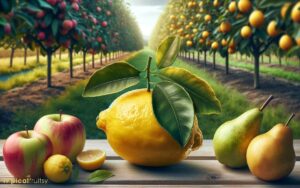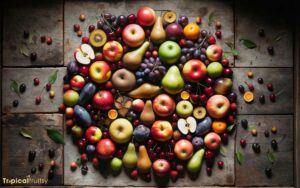What Are Non Tropical Fruits? Explained!
Non-tropical fruits, also known as temperate fruits, are varieties that flourish in moderate climatic regions.
These fruits typically require a cooler growing environment with distinct seasons, including cold winters and warm summers, unlike tropical fruits that prefer continuous warm conditions.
Common non-tropical fruits encompass apples, pears, cherries, and various berries, which are essential to diets worldwide due to their nutritional benefits and adaptability in numerous culinary applications.
Non-tropical fruits develop best in climates that experience a significant change in temperature between seasons.
The cold of winter is crucial for their dormancy phase, which is a period of rest that prepares them for fruitful production in the spring and summer months.
These fruits are predominantly cultivated in the temperate zones of the Earth, which include:
Discover the diverse world of non-tropical fruits, from the orchard-grown apples to the vine-ripened berries, enriching our diets and cuisines.

Key Takeaway
Non-Tropical Fruits: Harvest Seasons & Climate Requirements
| Non-Tropical Fruit | Typical Harvest Season | Climate Requirements |
|---|---|---|
| Apple | Late Summer – Fall | Cold winters, warm summers |
| Pear | Late Summer – Fall | Cold winters, warm summers |
| Cherry | Late Spring – Summer | Cold winters, mild summers |
| Blueberry | Summer | Cold winters, warm summers |
| Raspberry | Summer – Early Fall | Cold winters, warm summers |
| Grape | Late Summer – Fall | Cold winters, warm summers |
| Plum | Summer | Moderate climate with distinct seasons |
Defining Non-Tropical Fruits
Non-tropical fruits refer to those cultivated or occurring naturally in temperate zones, typically outside the equatorial regions where tropical fruits flourish.
Adapted to withstand cooler climates and often requiring a period of dormancy, these fruits exhibit characteristics distinct from their tropical counterparts.
The growth and development of non-tropical fruits are contingent upon specific chill hours—periods of low temperatures essential for breaking dormancy. This requirement delineates their cultivation range and influences their seasonal availability.
Examples include apples, pears, and cherries, which are characterized by their deciduous nature, losing leaves during the dormant season.
In contrast to tropical fruits, which often present a year-round growing season, non-tropical fruits have evolved to synchronize their fruiting cycles with temperate seasonal changes, ensuring optimal conditions for seed dispersal and survival.
Common Characteristics
While tropical fruits often thrive in continuous warmth, non-tropical fruits typically share characteristics such as a requirement for chill hours and a deciduous lifecycle, aligning their growth patterns with the cooler seasons of temperate regions.
These fruits generally necessitate a specific number of hours below a certain temperature threshold to break dormancy and ensure proper flowering and fruit set.
This chilling requirement varies among species and cultivars, influencing their geographic adaptability.
Moreover, non-tropical fruits are predominantly produced by perennial plants, which shed their leaves annually hence their deciduous nature.
The phenological development of these plants is closely synchronized with seasonal temperature variations, prompting physiological responses like dormancy in winter, which is crucial for the survival and productivity of the species in non-tropical environments.
Popular Varieties
Moving beyond the general characteristics of non-tropical fruits, it is pertinent to examine the specific varieties that dominate this category.
Apples, pears, and stone fruits such as peaches and cherries exemplify common temperate fruits, each with unique seasonal availability that affects global markets and consumption patterns.
Additionally, the nutritional profiles of these fruits are significant, providing essential vitamins, fiber, and other nutrients that contribute to a balanced diet.
Common Temperate Fruits
Temperate climates give rise to a diverse array of fruits, including widely-consumed varieties such as apples, pears, peaches, and cherries.
These fruits thrive in regions with distinct seasons, requiring a period of winter chill to break dormancy and ensure fruitful blossoms in spring.
- Apples (Malus domestica): Cultivated globally, apples display a broad genetic diversity, resulting in thousands of cultivars with variations in color, texture, and flavor. Optimal growth demands cold winters and moderate summer temperatures.
- Pears (Pyrus spp.): Pears flourish in similar climates to apples, with some varieties, like the European pear, requiring more chilling hours. They are valued for their delicate, buttery texture and are categorized into European and Asian species.
- Stone Fruits: This group includes peaches (Prunus persica) and cherries (Prunus spp.), which demand well-drained soil and sufficient winter chilling. The fruits are characterized by a fleshy exterior and a hard pit or ‘stone’ within.
Seasonal Availability
Non-tropical fruits such as apples, pears, and stone fruits have distinct harvesting seasons, which vary according to the specific variety and regional climate.
These fruits’ availability is crucial for consumers who seek freshness and for industries that depend on their production cycles.
The table below delineates popular varieties and their typical seasonal availability, which is subject to change due to climatic variations.
| Fruit Type | Variety | Peak Season |
|---|---|---|
| Apple | Honeycrisp | September-October |
| Pear | Bartlett | August-September |
| Cherry | Bing | June-July |
| Peach | Freestone | July-August |
Understanding these seasonal patterns allows for strategic planning in agriculture, distribution, and marketing, ensuring that these fruits reach consumers at their optimal ripeness and flavor profile.
It also informs culinary professionals and enthusiasts when to expect the best quality ingredients for their creations.
Nutritional Profiles
Each non-tropical fruit’s nutritional profile offers a unique combination of vitamins, minerals, and dietary fiber, essential for a balanced diet.
To illustrate:
- Apples: A medium-sized apple contains approximately 95 calories, 4 grams of dietary fiber, and is a good source of vitamin C and potassium. The phytonutrients in apples, such as quercetin, may offer antioxidant benefits.
- Grapes: A cup of grapes provides about 104 calories, 1.4 grams of fiber, and is rich in vitamins C and K. Grapes also contain resveratrol, a compound with potential heart-healthy properties.
- Pears: One medium pear has around 101 calories and 6 grams of fiber. Pears are a good source of vitamin C, vitamin K, and copper, supporting immune function and cardiovascular health.
As we analyze the nutrient compositions of these fruits, we can surmise that climate and soil conditions play pivotal roles in their development. This segues into the importance of growing regions and climates for non-tropical fruits.
Growing Regions and Climates
Non tropical fruits predominantly thrive in regions with temperate climates, characterized by distinct seasonal changes and moderate temperatures.
These climates facilitate the growth cycle of such fruits, which often require a period of cold dormancy followed by gradual warming.
For instance, apples, pears, and plums necessitate chilling periods to break dormancy and ensure proper bud development and fruit set.
This adaptation to temperate zones means that non tropical fruits are primarily cultivated in regions that experience winter frosts and mild summers.
The precise agricultural zones for growth vary by species, but generally, non tropical fruits are found between the latitudes of 30° and 60° in both hemispheres.
Within these belts, local microclimates, soil conditions, and topography further refine the suitable growing areas, demanding a nuanced understanding from horticulturists to optimize fruit yield and quality.
Health Benefits
Beyond their adaptability to cooler climates, non tropical fruits offer a plethora of health benefits, including essential vitamins, minerals, and dietary fiber that are crucial for maintaining overall wellness.
- Antioxidant Properties: Many non tropical fruits are rich in antioxidants such as vitamin C and flavonoids, which can help protect the body against oxidative stress and reduce the risk of chronic diseases.
- Metabolic Regulation: These fruits often have a low glycemic index, contributing to better blood sugar control and assisting in the management of diabetes.
- Heart Health: The fiber content in non tropical fruits can aid in lowering cholesterol levels, thus supporting cardiovascular health.
Each of these attributes is substantiated by rigorous nutritional studies, underscoring their significance in a balanced diet.
As we appreciate their health merits, let’s explore the diverse culinary uses of non tropical fruits in the next section.
Culinary Uses
Non-tropical fruits play a versatile role in culinary applications, ranging from their incorporation as essential ingredients in desserts to their utilization as nuanced accents in savory dishes.
The specific textural properties and flavor profiles of these fruits make them integral to creating balanced and sophisticated palates in both sweet and savory recipes.
Additionally, their nutritional attributes are maximized when employed as healthful snack options, aligning culinary indulgence with dietary prudence.
Dessert Ingredient Options
While tropical fruits often steal the spotlight for their exotic flavors, non-tropical fruits such as apples, pears, and berries provide versatile and foundational ingredients for a plethora of dessert recipes.
These fruits are celebrated for their adaptability and the sophisticated balance they bring to sweet culinary creations.
Here are some analytical observations on their use:
- Apples: Offer structural integrity in baked goods like pies and tarts due to their pectin content, which acts as a natural thickening agent.
- Pears: Their delicate sweetness and smooth texture make them ideal for poaching, complementing the infusion of spices and wine.
- Berries: With a balance of sweetness and acidity, berries are perfect for coulis, sauces, and as fresh garnishes, providing a burst of flavor and color.
Each fruit’s unique chemical composition, such as acidity and sugar content, influences how it behaves in different dessert applications, affecting taste, texture, and stability.
Savory Dish Accents
Apples, when employed as a tart counterpoint in savory pork dishes, demonstrate the culinary versatility of non-tropical fruits beyond the realm of desserts.
The acidity and sweetness of apples can balance the richness of pork, while their firm texture contributes a contrasting mouthfeel.
Similarly, pears, with their subtle sweetness and soft texture, can be poached in wine and herbs to accompany game meats, providing a nuanced flavor profile.
Stone fruits such as plums and cherries, when reduced into sauces or chutneys, lend a robust depth to poultry and red meat dishes with their complex interplay of sweetness, tartness, and spice.
These fruits act as sophisticated flavor agents, enhancing the savoriness of proteins through acidulation, while also imparting a natural sweetness that can mitigate the need for added sugars.
Healthful Snack Choices
Nutrition plays a pivotal role in the appeal of non-tropical fruits as healthful snack options, offering a plethora of vitamins, minerals, and fibers in a convenient and flavorful package.
These nutrient-dense foods provide essential compounds that facilitate various bodily functions, contributing to overall well-being.
Analytically, the culinary uses of non-tropical fruits as snacks can be itemized as follows:
- Apples: Rich in dietary fiber and vitamin C, they can be eaten raw or incorporated into salads for a nutritious crunch.
- Berries: Blueberries, strawberries, and raspberries contain high levels of antioxidants and can be consumed alone or as toppings for yogurt and cereals.
- Pears: With a low glycemic index, pears are ideal for a slow-release energy snack, beneficial for blood sugar control.
Understanding the health benefits and culinary versatility of these fruits is crucial for informed consumption.
The next section will address the importance of preservation and storage to maintain the quality and extend the shelf life of non-tropical fruits.
Preservation and Storage
Proper preservation and storage of non-tropical fruits, such as pears, plums, and peaches, is essential for maintaining their freshness and extending shelf life. These fruits generally require conditions that inhibit microbial growth and enzymatic degradation.
The following table provides an overview of optimal storage parameters for selected non-tropical fruits:
| Fruit | Temperature (°C) | Relative Humidity (%) | Expected Shelf Life |
|---|---|---|---|
| Pears | 0 to 4 | 90 to 95 | 1 to 3 months |
| Plums | 0 to 1 | 90 to 95 | 2 to 4 weeks |
| Peaches | -0.5 to 0 | 90 to 95 | 2 to 4 weeks |
| Apples | 0 to 4 | 90 to 95 | 1 to 6 months |
| Grapes | -1 to 0 | 85 to 90 | 1 to 2 months |
These parameters are critical to delaying senescence and preventing the loss of textural quality and nutritional content. Storage environments must be strictly controlled to optimize the post-harvest life of these fruits.
What Are Some Non-Tropical Fruits That Can Be Used in Place of Tropical Fruits?
What Are Some Non-Tropical Fruits That Can Be Used in Place of Tropical Fruits? When it comes to finding alternatives for tropical fruits, there are various options to explore. While tropical fruits offer unique flavors, non-tropical alternatives can step in. From apples and pears to berries like cranberries and blueberries, these fruits can bring interesting twists to your recipes. Incorporating these alternatives can expand your palette and keep your taste buds satisfied, even without tropical fruit life savers explained.
Seasonal Availability
Transitioning from storage considerations, understanding the seasonal availability of non-tropical fruits is crucial for consumers and suppliers alike to ensure the best quality and variety throughout the year.
The periodicity of harvest directly impacts:
- Market Prices: Supply surges during peak harvest time often lead to more competitive pricing.
- Nutritional Value: Fruits picked and consumed at their natural harvest time have optimal nutrient profiles.
- Ecological Footprint: Locally sourced, in-season fruits reduce the need for long-distance transportation and associated environmental costs.
An analytical approach to the seasonality of non-tropical fruits involves examining regional climate patterns, varietal growth cycles, and harvesting techniques.
Detailed knowledge of these factors enables informed decisions that align with sustainable consumption practices and support agricultural economies. Understanding these dynamics is integral to the fruit supply chain’s efficiency and resilience.
Conclusion
Non-tropical fruits represent a diverse group of botanical offerings vital to human nutrition and culinary diversity.
Characterized by their ability to thrive in temperate climates, these fruits provide essential nutrients and have been integrated into a myriad of food traditions. Their adaptability in preservation and storage extends their utility beyond seasonal availability.
The exploration of non-tropical fruits’ role in sustainable agriculture may offer insights into addressing global food security challenges.






